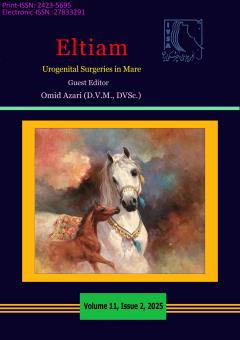Anesthetic Considerations for dystocia in mares
Subject Areas : Veterinary Soft and Hard Tissue Surgery
1 -
Keywords: Anesthesia, Dystocia, Cesarean section, Foal, Mare.,
Abstract :
Background: General anesthesia inherently carries a higher risk in horses than that for human and other domesticated animals, with cited mortality rates of 0.24–1.8% in healthy horses. The risk of mortality increases in both mare and foal in the last trimester of pregnancy, which is probably associated with a need for emergency surgery. The survival rates for mares presenting with dystocia are about 90% and for foals between 10% and 40%.
Aims: The present article reviews the anesthetic management of pregnant mare during cesarean section.
Methods: Reviewing the references about anesthetic management of pregnant mare during cesarean section.
Results: Cesarean section is most commonly performed as an emergency procedure to relieve dystocia, although it has occasionally been reported as an elective procedure in select cases when vaginal birth is deemed unlikely to be successful (e.g. due to maternal pelvic canal abnormalities). Although little information is available regarding pregnant horses, it is reasonable to assume that the physiology of mares is similar to that of other mammalian species. Major physiologic adaptations during late pregnancy present challenges for successful anesthetic management of equine patients. During pregnancy, the cardiovascular system must compensate for fetal oxygen demands. Pressure on the diaphragm, which is exacerbated by dorsal recumbency, may result in ventilation-perfusion mismatching and hypoxemia. Maintaining oxygen delivery to the fetus is of utmost importance in optimizing fetal health during anesthesia.
Conclusion: Anesthetic drugs/ protocols and monitoring techniques for pregnant mares undergoing anesthesia are similar to those used for the non-pregnant horses. However, pregnancy-induced physiological changes in mare and concerns for fetal viability may impact the anesthetist drugs selection. Anesthesia in a pregnant mare presents several challenges for the anesthetist to assure a good outcome for both the mare and the fetus.
